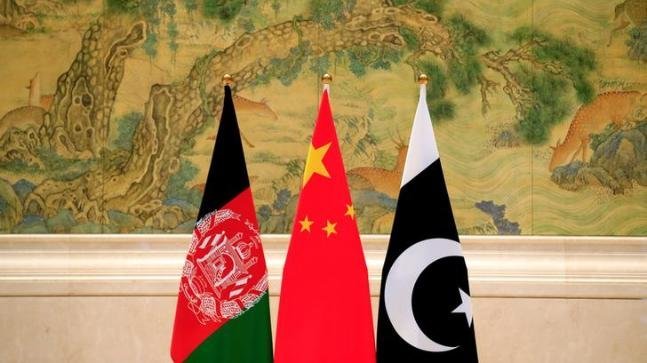In a significant geopolitical development, China, Pakistan and Afghanistan have agreed to extend the China–Pakistan Economic Corridor (CPEC) into Afghanistan. CPEC is a $60+ billion flagship project of China’s Belt and Road Initiative. So far it has been limited to projects within Pakistan.
After years of speculation, an announcement was made in May 2025, at a trilateral meeting in Beijing. Chinese Foreign Minister Wang Yi declared that CPEC “will now be extended into Afghanistan”. Pakistan’s Deputy PM/Foreign Minister Ishaq Dar attended the talks alongside Afghanistan’s acting Foreign Minister Amir Khan Muttaqi and likewise stated that the three sides agreed to deepen Belt and Road cooperation and expand CPEC inside Afghan territory.
This initiative effectively opens the door for infrastructure and connectivity projects in Afghanistan under the CPEC/BRI banner. It ranges from road and rail links to energy and trade facilitation projects, while exact projects and routes are yet to be detailed publicly. An obvious priority is improving the western corridor from Pakistan into Afghanistan.
It includes upgrading highways or proposing a railway from Peshawar or Quetta into Afghan cities to dovetail with CPEC’s existing network in Pakistan.
Including Afghanistan into the project signals China’s strategic commitment to the war-torn country’s economic integration even as security and financing challenges persist. Notably, Beijing’s announcement came along a diplomatic breakthrough between Pakistan and Afghanistan; signaling that CPEC’s extension is as much an economic venture as it is a tool for regional rapprochement.
China’s role has extended beyond funding bricks and mortar. It has also emerged as a diplomatic mediator working to normalize Pakistan-Afghanistan relations. Ties between Islamabad and the Taliban government in Kabul have been strained since the Taliban’s 2021 takeover, on account of issues like cross-border militancy and refugee flows.
In this context, China leveraged its influence to bring the two sides to the table. The May 21 trilateral meeting in Beijing was part of a forum first launched in 2017. It was revived by China to ease tensions. Wang Yi announced that Pakistan and Afghanistan had agreed “in principle” to restore full diplomatic relations by exchanging ambassadors – an important step after nearly four years without ambassadors in each other’s capitals.
Beijing’s encouragement was key. Wang Yi said, “China welcomed this and will continue to provide assistance for the improvement of Afghanistan-Pakistan relations.” Shortly after, Pakistan confirmed it would elevate its mission in Kabul to ambassador level and the Taliban administration reciprocated. This diplomatic thaw did not happen in isolation. It was likely facilitated by China’s quiet shuttle diplomacy coming on the heels of Chinese officials meeting both Afghan and Pakistani counterparts in the preceding months.
The Beijing trilateral talks also saw all sides underscore commitments to jointly combat terrorism and boost economic cooperation. And extending CPEC northward is driven by clear strategic interests. The focus is on security cooperation particularly against the Pakistani Taliban (TTP) and Uyghur militants (ETIM).
China’s investments in Pakistan have been targeted by militant groups, including the TTP, which has killed around 20 Chinese nationals since 2021. Instability on Pakistan’s western frontier directly threatens CPEC projects and personnel. Likewise, Afghanistan, under the Taliban, harbors elements of the regional Islamic State and has been a haven for the TTP – trends that alarm Islamabad and Beijing alike.
China used its leverage to push the Taliban to rein in these groups, with the Beijing trilateral explicitly tying counterterrorism cooperation to economic incentives.
Incorporating Afghanistan into BRI (via CPEC) not only helps stabilize China’s neighborhood but also potentially gives China access to Afghanistan’s estimated $1 trillion in mineral resources (copper, rare earths, lithium, etc.) which could be tapped through future investments.
Moreover, the extension can eventually provide China a direct overland route to resource-rich Central Asia and even to Iran, complementing other BRI corridors.
There is also a regional diplomacy angle: by sponsoring development and dialogue, China bolsters its image as a peace-broker and benefactor in South Asia. This can counter rival influences – for example, India’s outreach to the Taliban. Notably, India has quietly engaged Taliban officials and even hosted some visits too.
China’s deeper involvement in Kabul provides an alternative partnership to the Taliban that aligns with Pakistan’s interests.
Ultimately, China’s approach is a blend of realpolitik and economic statecraft: stabilize the Afghan-Pakistan nexus to secure its western frontier, extend its Belt and Road footprint and ensure that no power vacuum invites unrest that could spill over in Xinjiang.
All of this contributes to a more stable environment, which is necessary for large-scale projects to succeed. Observers note that China’s convening power has lent credibility to these efforts, though sustaining the momentum will require consistent follow through by Islamabad and Kabul.
There are also potential challenges and critiques. India, for one, views the extension of CPEC into Afghanistan with suspicion, given that CPEC already runs through areas of Kashmir claimed by India. New Delhi fears a growing China-Pakistan-Afghanistan alignment could encircle India strategically.
In sum, the extension of CPEC and China’s diplomatic activism mark a bold experiment in tying reconciliation to development. The coming years will test whether this approach yields the desired stability but for now, it has opened a new chapter in regional connectivity with Beijing at the helm, and cautious optimism in Islamabad and Kabul.




